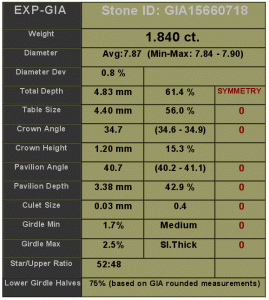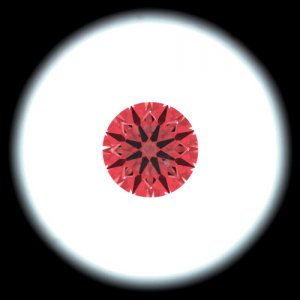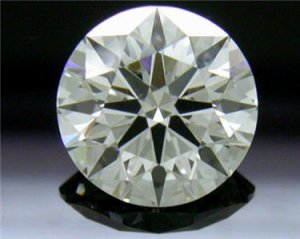You are using an out of date browser. It may not display this or other websites correctly.
You should upgrade or use an alternative browser.
You should upgrade or use an alternative browser.
Diamond Opinions - photo, idealscope & sarin included
- Thread starter stook1
- Start date
- Status
- Not open for further replies. Please create a new topic or request for this thread to be opened.
- Joined
- Sep 3, 2000
- Messages
- 6,756
- Joined
- Apr 22, 2004
- Messages
- 38,363
- Joined
- Apr 22, 2004
- Messages
- 38,363
I think you''ll be hard pressed to see it in person. On my computer screen, the diamond is as large as the palm of my hand (if only my diamond was really that size
 ), so when properly minimized in size to a more realistic size, that dot becomes even tinier/microscopic. For a peace of mind, why not ask Whiteflash?
), so when properly minimized in size to a more realistic size, that dot becomes even tinier/microscopic. For a peace of mind, why not ask Whiteflash?

kcoursolle
Super_Ideal_Rock
- Joined
- Jan 21, 2006
- Messages
- 10,612
Unfortunately, it seems that different IdealScope images taken at different times vary due to equipment set up. I have had some variation explained to me as "photos were taken with different equipment at different times". From looking at a lot of IS images on WF, I've noticed that sometimes the diamond is much larger, and at other times smaller with more white background. (Maybe that's just a difference b/w ACA and ES images, haven't tried to correlate it). If so, it makes it hard to compare intensities between images.
Perhaps John Q can address this for us? I'm a scientist in image processing and wouldn't mind the full geek treatment! Whaddya say John?
Perhaps John Q can address this for us? I'm a scientist in image processing and wouldn't mind the full geek treatment! Whaddya say John?
MWG
Brilliant_Rock
- Joined
- Jan 24, 2007
- Messages
- 530
I guess that is a positive vote! This is not an ACA (or even an ES for that matter). Also, I just realized that I forgot to mention earlier that this is a J colored stone. That would help in considering price/value!Date: 6/27/2007 6:22:40 PM
Author: MWG
Cant go wrong with an ACA!!!!!! Ours SPARKLES and SHINES everyday for us..
sunshine14
Shiny_Rock
- Joined
- Jul 2, 2005
- Messages
- 247
jstarfireb
Ideal_Rock
- Joined
- Mar 24, 2007
- Messages
- 6,232
$8850 for a 1.8ct RB that scores 1 on the HCA and has those gorgeous images?!? Sounds too good to be true, but if it''s not...reserve that diamond right now, because you won''t find another deal like that again! I''m wondering why this isn''t an ES stone, because it''s really fabulous. People are actually mistaking it for an ACA - that tells you something!
One little thing - you didn''t post the clarity, so if it''s SI1 or SI2, make sure it''s eye-clean before you buy it.
One little thing - you didn''t post the clarity, so if it''s SI1 or SI2, make sure it''s eye-clean before you buy it.
Date: 6/27/2007 6:54:17 PM
Author: sunshine14
I think it looks great! And if it is the one I found on WF''s website with those specs...then I think it is a great deal as well!
Mine had similar basic specs, and it was a bit more than that...and I love mine!
Good luck!
Thanks Sunshine! You, in fact, are the one that had pointed out this one in my thread about the K stones. Jamie at Whiteflash has been super helpful while I have been looking so I had it sent to WF, of course.
sunshine14
Shiny_Rock
- Joined
- Jul 2, 2005
- Messages
- 247
Ahh...It''s so sad that I feel a sense of pride over this comment! Ha!Date: 6/27/2007 7:28:52 PM
Author: stook1
Date: 6/27/2007 6:54:17 PM
Author: sunshine14
I think it looks great! And if it is the one I found on WF''s website with those specs...then I think it is a great deal as well!
Mine had similar basic specs, and it was a bit more than that...and I love mine!
Good luck!
Thanks Sunshine! You, in fact, are the one that had pointed out this one in my thread about the K stones. Jamie at Whiteflash has been super helpful while I have been looking so I had it sent to WF, of course.
I''m glad that it turned out to look this good! Let us know what you decide!
JohnQuixote
Ideal_Rock
- Joined
- Sep 9, 2004
- Messages
- 5,212
Date: 6/27/2007 5:51:56 PM
Author: diasurfer
Unfortunately, it seems that different IdealScope images taken at different times vary due to equipment set up. I have had some variation explained to me as 'photos were taken with different equipment at different times'. From looking at a lot of IS images on WF, I've noticed that sometimes the diamond is much larger, and at other times smaller with more white background. (Maybe that's just a difference b/w ACA and ES images, haven't tried to correlate it). If so, it makes it hard to compare intensities between images.
Perhaps John Q can address this for us? I'm a scientist in image processing and wouldn't mind the full geek treatment! Whaddya say John?
You heard right ds, overall hue in reflector photos is influenced by ambient lighting, strength of the light source behind the stone, camera settings and the specific reflector being used. When analyzing IS photos one should look for consistency of hue throughout the diamond, not for how dark or light the overall red is. The different zooms represent changes in setup & magnification.We’re taking hundreds of photos a week and always working to evolve the process for both IS and ASET. Thanks for the geek request... We aim to please.

Date: 6/28/2007 4:46:17 PM
Author: JohnQuixote
Date: 6/27/2007 5:51:56 PM
Author: diasurfer
Unfortunately, it seems that different IdealScope images taken at different times vary due to equipment set up. I have had some variation explained to me as ''photos were taken with different equipment at different times''. From looking at a lot of IS images on WF, I''ve noticed that sometimes the diamond is much larger, and at other times smaller with more white background. (Maybe that''s just a difference b/w ACA and ES images, haven''t tried to correlate it). If so, it makes it hard to compare intensities between images.
Perhaps John Q can address this for us? I''m a scientist in image processing and wouldn''t mind the full geek treatment! Whaddya say John?
You heard right ds, overall hue in reflector photos is influenced by ambient lighting, strength of the light source behind the stone, camera settings and the specific reflector being used. When analyzing IS photos one should look for consistency of hue throughout the diamond, not for how dark or light the overall red is. The different zooms represent changes in setup & magnification.We’re taking hundreds of photos a week and always working to evolve the process for both IS and ASET. Thanks for the geek request... We aim to please.
Cool! Mahalo.
Not that you asked ... but when I''m not on the computer reading about diamonds, I am developing algorithms for an R&D instrument that captures images of the cervix for cancer detection. They are oddly reminscent of idealscope images: small, pink, round, and a dark spot in the middle. Maintaining a uniform calibrated light source and focal distance is a HUGE deal for us. Taken up the best part of 6 months for me. We adjust exposure time but never gain. Still, hard to account for that darned variable ambient lighting. For the most part, our cancer detection algorithms work the same way as your advice for interpreting IS images:
"look for consistency of hue throughout the diamond, not for how dark or light the overall red is"
Date: 6/28/2007 4:46:17 PM
Author: JohnQuixote
Date: 6/27/2007 5:51:56 PM
Author: diasurfer
Unfortunately, it seems that different IdealScope images taken at different times vary due to equipment set up. I have had some variation explained to me as ''photos were taken with different equipment at different times''. From looking at a lot of IS images on WF, I''ve noticed that sometimes the diamond is much larger, and at other times smaller with more white background. (Maybe that''s just a difference b/w ACA and ES images, haven''t tried to correlate it). If so, it makes it hard to compare intensities between images.
Perhaps John Q can address this for us? I''m a scientist in image processing and wouldn''t mind the full geek treatment! Whaddya say John?
You heard right ds, overall hue in reflector photos is influenced by ambient lighting, strength of the light source behind the stone, camera settings and the specific reflector being used. When analyzing IS photos one should look for consistency of hue throughout the diamond, not for how dark or light the overall red is. The different zooms represent changes in setup & magnification.We’re taking hundreds of photos a week and always working to evolve the process for both IS and ASET. Thanks for the geek request... We aim to please.
Thanks for the explanation, John. Just out of curiousity, could you offer some insight into the IS image posted above? Obviously others have chimed in with positive feedback... Seems pretty good to me but I most certainly lack the background and context to evaluate how this might compare against the superb diamonds that you carry.
Also, since you are paying attention, I just wanted to let you know that Jamie has done a superb job helping me out and that she is wonderful to work with. Thanks for your contribution to the pricescope community. I would have been utterly lost without the help of people like yourself.
thanks!
JohnQuixote
Ideal_Rock
- Joined
- Sep 9, 2004
- Messages
- 5,212
Date: 6/28/2007 5:38:11 PM
Author: diasurfer
Cool! Mahalo.
Not that you asked ... but when I'm not on the computer reading about diamonds, I am developing algorithms for an R&D instrument that captures images of the cervix for cancer detection. They are oddly reminscent of idealscope images: small, pink, round, and a dark spot in the middle. Maintaining a uniform calibrated light source and focal distance is a HUGE deal for us. Taken up the best part of 6 months for me. We adjust exposure time but never gain. Still, hard to account for that darned variable ambient lighting. For the most part, our cancer detection algorithms work the same way as your advice for interpreting IS images:
'look for consistency of hue throughout the diamond, not for how dark or light the overall red is'
Mahalo nui loa (from an admitted haole

WorkingHardforSmallRewards
Brilliant_Rock
- Joined
- Jun 5, 2007
- Messages
- 1,236
JohnQuixote
Ideal_Rock
- Joined
- Sep 9, 2004
- Messages
- 5,212
Thanks for the bump.
 I think the input you''ve received on the IS is good. If you have specific questions one of us at WF will be glad to speak with you and address them. As for PS, it''s great that we''re living at a time where this kind of interactivity is possible. Glad to be of assistance!
I think the input you''ve received on the IS is good. If you have specific questions one of us at WF will be glad to speak with you and address them. As for PS, it''s great that we''re living at a time where this kind of interactivity is possible. Glad to be of assistance!
Stook1 we appreciate the kind comments about Jamie - we like her too.Date: 6/28/2007 6:06:06 PM
Author: stook1
Thanks for the explanation, John. Just out of curiousity, could you offer some insight into the IS image posted above? Obviously others have chimed in with positive feedback... Seems pretty good to me but I most certainly lack the background and context to evaluate how this might compare against the superb diamonds that you carry.
Also, since you are paying attention, I just wanted to let you know that Jamie has done a superb job helping me out and that she is wonderful to work with. Thanks for your contribution to the pricescope community. I would have been utterly lost without the help of people like yourself.
thanks!

- Status
- Not open for further replies. Please create a new topic or request for this thread to be opened.
Share:
How Are Diamonds Made? Natural vs Lab-Created Explained How Are Diamonds Made? Natural vs Lab-Created Explained - 08/05
How Are Diamonds Made? Natural vs Lab-Created Explained - 08/05

Top Wedding Ring Brands for Every Style and Budget
Top Wedding Ring Brands for Every Style and Budget - 08/05
Where to Buy Lab Grown Diamonds: Best Places Compared
Where to Buy Lab Grown Diamonds: Best Places Compared - 08/05











300x240.png)